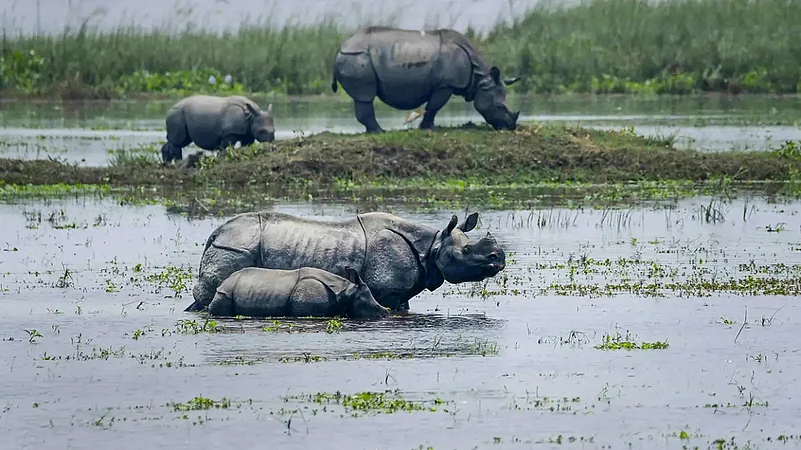Assam's three major habitats for one-horned rhinoceros are facing threat, not just from poachers but also from several invasive plant species that are posing a grave danger to the grasslands, prompting interventions in some areas to save the fodder for the animals.
Various invasive plant species that tend to destroy the grasslands have been found in abundance in Kaziranga and Manas National Park as well as the Pobitora Wildlife sanctuary, home to rhinoceros, elephant, swamp deer among other animals.
Experts have sought immediate measures for ensuring long-term conservation of all grassland-dependent species.
In Kaziranga National Park (KNP), authorities, under the Wildlife Institute of India's project 'Management of Invasive Species', have sought permission for experimental culling, cutting, slashing, uprooting, and girdling of vegetation.
KNP Field Director Jatindra Sarma told PTI "We have come across several species of plants of invasive nature, mostly annual or perennial herbs, identified as weeds, which adversely impact the grasslands. Besides, there are some plants that have a toxic impact under water."
Some of the 18 invasive species of plants identified in the park are Bombax ceiba, Trewia nudiflora-Gutel/B Crataeva nurvala, Lagerstroemia speciosa and Cestrum diurnum, Sarma pointed out.
KNP, along with Wildlife Institute of India and leading NGOs, is working on a project to weed out the invasive species which are seriously affecting the flora and fauna of the park, he said.
The KNP field director, however, pointed out that one particular weed, ‘Cestrum diurnum’, has high medicinal value.
"Being a source of Vitamin D-3, 'Cestrum diurnum’ is often smuggled out by unscrupulous traders. I have already contacted a Delhi-based manufacturing company for commercial cultivation of the species," he maintained.
In Manas National Park (MNP), a habitat restoration project is already underway by biodiversity organisation 'Aaranyak', in collaboration with the biosphere reserve authorities and forest department.
Bibhuti Prasad Lahkar of 'Aaranyak' said plans are afoot to extend the project to Pobitora once the flood waters recede. "We found that approximately 30 per cent of the grassland habitat in Manas has been affected due to the invasion, primarily by two species ‘Chromolena Odonta’ and ‘Mikania Micrantha’.
"Using Species Distribution Modelling (SDM) approach, we inferred that immediate management intervention was needed for ensuring long-term conservation and benefit of all grassland-dependent species," he told PTI.
Lahkar, who is leading the habitat restoration initiative at MNP, said that they had applied three treatments initially -- manually uprooting the invasive plants, cutting the invasive plants above-ground and cutting or burning of the invasive plants -- to find out which one works the best.
"We identified manual uprooting as the best method to arrest invasion and promote the growth of native grass species. On an experimental basis, we had selected a grassland plot of one hectare which was completely invaded by Chromolaena and applied the manual uprooting method for three consecutive years," he said.
Uprooting was carried out just before the flowering of these invasive plants in September to control the wind dispersal of seeds, and with each annual cycle, the abundance of the species decreased, he explained.
"During the restoration work, we have learned that the site needs to be maintained for at least three to five years, protecting it from livestock grazing and other anthropogenic disturbances. After the removal of invasive plants in the first year, it may be followed by plantation of native grass species for better results," Lahkar said.
Local communities in fringe areas of MNP have played a major role with youths engaged in the process to supplement their livelihood with daily wages, he said
"We are also planning to take this initiative to Pobitora, which has the highest concentration of one-horned rhinos and where invasive species have led to habitat destruction," Lahkar added.
(With PTI inputs)


























